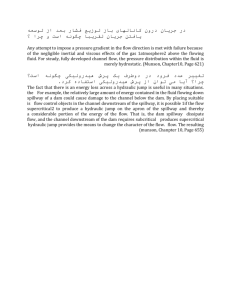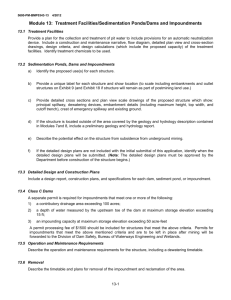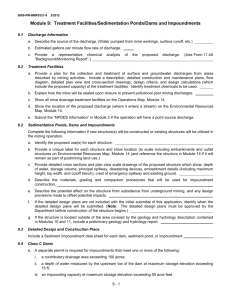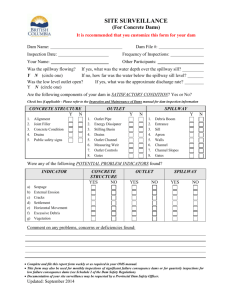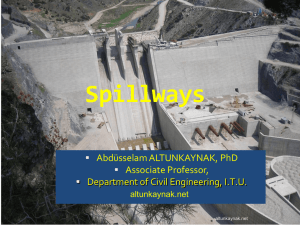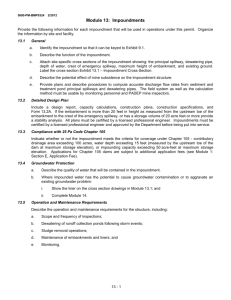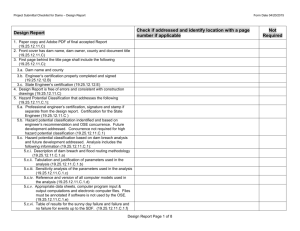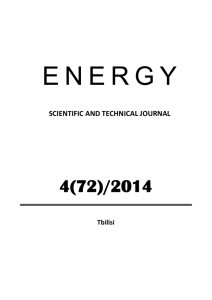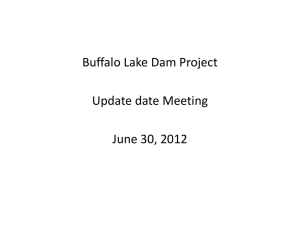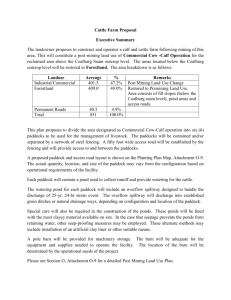Design of Emergency Spillway and Top of Dam
advertisement
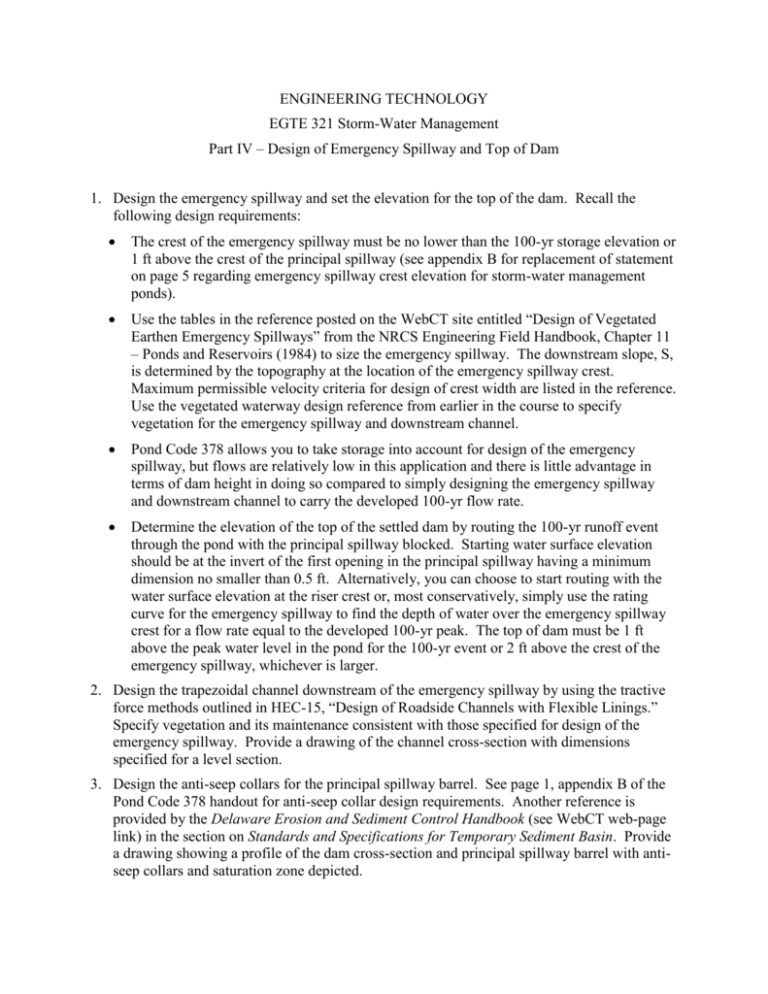
ENGINEERING TECHNOLOGY EGTE 321 Storm-Water Management Part IV – Design of Emergency Spillway and Top of Dam 1. Design the emergency spillway and set the elevation for the top of the dam. Recall the following design requirements: The crest of the emergency spillway must be no lower than the 100-yr storage elevation or 1 ft above the crest of the principal spillway (see appendix B for replacement of statement on page 5 regarding emergency spillway crest elevation for storm-water management ponds). Use the tables in the reference posted on the WebCT site entitled “Design of Vegetated Earthen Emergency Spillways” from the NRCS Engineering Field Handbook, Chapter 11 – Ponds and Reservoirs (1984) to size the emergency spillway. The downstream slope, S, is determined by the topography at the location of the emergency spillway crest. Maximum permissible velocity criteria for design of crest width are listed in the reference. Use the vegetated waterway design reference from earlier in the course to specify vegetation for the emergency spillway and downstream channel. Pond Code 378 allows you to take storage into account for design of the emergency spillway, but flows are relatively low in this application and there is little advantage in terms of dam height in doing so compared to simply designing the emergency spillway and downstream channel to carry the developed 100-yr flow rate. Determine the elevation of the top of the settled dam by routing the 100-yr runoff event through the pond with the principal spillway blocked. Starting water surface elevation should be at the invert of the first opening in the principal spillway having a minimum dimension no smaller than 0.5 ft. Alternatively, you can choose to start routing with the water surface elevation at the riser crest or, most conservatively, simply use the rating curve for the emergency spillway to find the depth of water over the emergency spillway crest for a flow rate equal to the developed 100-yr peak. The top of dam must be 1 ft above the peak water level in the pond for the 100-yr event or 2 ft above the crest of the emergency spillway, whichever is larger. 2. Design the trapezoidal channel downstream of the emergency spillway by using the tractive force methods outlined in HEC-15, “Design of Roadside Channels with Flexible Linings.” Specify vegetation and its maintenance consistent with those specified for design of the emergency spillway. Provide a drawing of the channel cross-section with dimensions specified for a level section. 3. Design the anti-seep collars for the principal spillway barrel. See page 1, appendix B of the Pond Code 378 handout for anti-seep collar design requirements. Another reference is provided by the Delaware Erosion and Sediment Control Handbook (see WebCT web-page link) in the section on Standards and Specifications for Temporary Sediment Basin. Provide a drawing showing a profile of the dam cross-section and principal spillway barrel with antiseep collars and saturation zone depicted. Assessment Form: Relative Contributions of Team Members1 Participant: _____________________________________ Team: ___________________________ Date: __________________ SWM Design Project Part IV Comments Storm-Water Management Group Design Project Team members (include yourself) Individual contributions to this team project2 1. 2. 3. 4. 5. 1 After Fletcher, Lugowski, and Stern. 2002. Fluid Power Facilitator Guide. Sinclair Community College. 2 Allocate 100 points to your team members, including yourself. Base the allocation on your opinion of each individual’s contribution. The sum of all points allocated must equal 100. SWM Design Project Part IV: Emergency Spillway Design and Top of Dam Grading Rubric Highly Competent Competent Needs Improvement Task (2) (1) (0) Narrative, appendices, and supporting materials as described in assignment. Report is complete with clear, concise discussion of relevant regulations, assumptions, and design considerations. Analysis is complete and done correctly. All relevant supporting documentation is included in appendices. Report is complete; design work and analysis are supported with adequate documentation and some commentary regarding major regulatory aspects, assumptions, and design considerations. There may be one or two minor omissions or errors in analysis. Report incomplete and analysis is inadequate or faulty with little or no discussion of major regulatory aspects, assumptions, and design considerations. There may be significant design errors or the design may be inadequately documented. Specific Components: Narrative – Provide discussion of these items including all design details: - Pond Code 378 Criteria - Elevation of Emergency Spillway Crest determined by routing results and elevation of principal spillway crest. Include consideration of alternatives. - Design of Emergency Spillway Crest Width. Include supporting flow data from routing and specification of vegetation. - Design for Top of Dam with supporting hydrologic routing or hydraulics data and consideration of alternatives. - Design for Emergency Spillway Channel by the tractive force method with supporting flow data, construction specifications, and drawings. Include specification of vegetation and maintenance. - Anti-Seep collar design with specifications and drawings. Appendices - Appropriate computer output. - Reference figures or tables - Appropriate calculation details for any of the design work in the Narrative.
